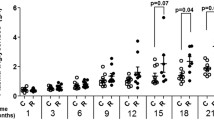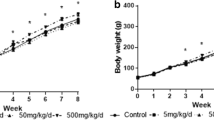Abstract
Triptolide is the main active component of Tripterygium wilfordii Hook. F., which is one of the forbidden species by the Chinese Ministry of Health. A GC–MS-based metabolomic approach was applied to estimate the adipose toxicity induced by triptolide. The metabolomic study discovered that triptolide exposure caused a remarkable increase in fatty acids. For instance, nonanoic acid, dodecanoic acid, cis-9-hexadecenoic acid, hexadecanoic acid, 9,12-octadecadienoic acid, trans-9-octadecenoic acid, octadecanoic acid, arachidonic acid, and eicosanoic acid increased from 1.03- to 10.21-fold in high-dose triptolide-exposed rats compared to the control group. In addition, l-alanine, glycine, l-valine, fumaric acid, l-proline, glucose, and l-tyrosine were observed to have a down-regulation in the adipose tissue, induced by triptolide exposure. Many metabolites in high-dose group demonstrated the noticeable alterations in adipose tissue of rats brought by triptolide exposure, although the difference between low-dose group and control group was not noted. The results illustrated not only fatty acid β-oxidation, lipid accumulation, and reduction of amino acids in the adipose tissue of SD rats because of triptolide exposure, but also that the tricarboxylic acid cycle was influenced. A metabolomic method was successful in finding latent biomarkers.
Graphical Abstract







Similar content being viewed by others
References
Xu XL, Shang Y, Jiang JG (2016) Plant species forbidden in health food and their toxic constituents, toxicology and detoxification. Food Funct 7:643–664
Liu J, Li L, Zhou X, Chen XY, Huang HH, Zhao SB, Li XL, Zhong DF (2013) Metabolite profiling and identification of triptolide in rats. J Chromatogr B 939:51–58
Klawitter M, Hakozaki M, Kobayashi H, Krupkova O, Quero L, Ospelt C, Gay S, Hausmann O, Liebscher T, Meier U (2014) Expression and regulation of toll-like receptors (TLRs) in human intervertebral disc cells. Eur Spine J 23:1878–1891
Geng Y, Fang MR, Wang J, Yu HY, Hu ZY, Yew DT, Chen W (2012) Triptolide down-regulates COX-2 expression and PGE2 release by suppressing the activity of NF-kB and MAP kinases in lipopolysaccharide-treated PC12 Cells. Phytother Res 26:337–343
Qiu DM, Zhao GH, Aoki Y, Shi LF, Uyei A, Nazarian S, Ng JCH, Kao PN (1999) Immunosuppressant PG490 (triptolide) inhibits T-cell interleukin-2 expression at the level of purine-box/nuclear factor of activated T-cells and NF-kappa B transcriptional activation. J Biol Chem 274:13443–13450
Willem VE (2009) Protective and therapeutic effect of triptolide in EAE explained by induction of major stress protein HSP70. J Neuroimmunol 217:10–11
Lu H, Hachida M, Enosawa S, Li XK, Suzuki S, Koyanagi H (1999) Immunosuppressive effect of triptolide in vitro. Transplant Proc 31:2056–2057
Wang W, Li XF, Sun WM, Zhang LR, Zhang M, Hong BZ, Lv GR (2012) Triptolide triggers the apoptosis of pancreatic cancer cells via the downregulation of Decoy receptor 3 expression. J Cancer Res Clin Oncol 138:1597–1605
Liu JJ, Shen M, Yue ZG, Yang ZF, Wang M, Li C, Xin CY, Wang YK, Mei QB, Wang ZP (2012) Triptolide inhibits colon-rectal cancer cells proliferation by induction of G1 phase arrest through upregulation of p21. Phytomedicine 19:756–762
Huang WW, He TT, Chai CS, Yang Y, Zheng YH, Zhou P, Qiao XX, Zhang B, Liu ZZ, Wang JR (2012) Triptolide inhibits the proliferation of prostate cancer cells and down-regulates SUMO-specific protease 1 expression. PLoS One 7:e37693
Liu L, Jiang ZZ, Liu J, Huang X, Wang T, Zhang Y, Zhou ZX, Guo JL, Yang LN (2010) Sex differences in subacute toxicity and hepatic microsomal metabolism of triptolide in rats. Toxicology 271:57–63
Yuan ZX, Wu XJ, Mo JX, Wang YL, Xu CQ, Lim LY (2015) Renal targeted delivery of triptolide by conjugation to the fragment peptide of human serum albumin. Eur J Pharm Biopharm 94:363–371
Kong LL, Zhuang XM, Yang HY, Mei Y, Liang X, Li H (2015) Inhibition of P-glycoprotein gene expression and function enhances triptolide-induced hepatotoxicity in mice. Sci Rep 5:11747–11760
Du FY, Liu T, Liu T, Wang YW, Wan YK, Xing J (2011) Metabolite identification of triptolide by data-dependent accurate mass spectrometric analysis in combination with online hydrogen/deuterium exchange and multiple data-mining techniques. Rapid Commun Mass Spectrom 25:3167–3177
Li W, Liu Y, He YQ, Zhang JW, Gao Y, Ge GB, Liu HX, Huo H, Liu HT, Wang LM (2008) Characterization of triptolide hydroxylation by cytochrome P450 in human and rat liver microsomes. Xenobiotica 38:1551–1565
Hu CQ, Lin SH, Cai ZW (2014) Fatty acid profiles reveal toxic responses in adipose tissue of C57BL/6J mice exposed to 2,3,7,8-tetrachlorodibenzo-p-dioxin. Anal Methods 6:8207–8211
Patti GJ, Yanes O, Siuzdak G (2012) Innovation: metabolomics: the apogee of the omics trilogy. Nat Rev Mol Cell Biol 13:263–269
Aa JY, Shao F, Wang GJ, Huang Q, Zha WB, Yan B, Zheng T, Liu LS, Cao B, Shi J (2011) Gas chromatography time-of-flight mass spectrometry based metabolomic approach to evaluating toxicity of triptolide. Metabolomics 7:217–225
Nicholson JK, Connelly J, Lindon JC, Holmes E (2002) Metabolomics: a platform for studying drug toxicity and gene function. Nat Rev Drug Discov 1:153–161
Liu X, Xue X, Gong LK, Qi XM, Wu YF, Xing GZ, Luan Y, Xiao Y, Wu XF, Li Y (2012) 1HNMR-based metabolomic analysis of triptolide-induced toxicity in liver-specific cytochrome P450 reductase knockout mice. Metabolomics 8:907–918
Ma B, Qi HH, Li J, Xu H, Chi B, Zhu JW, Yu LS, An GH, Zhang Q (2015) Triptolide disrupts fatty acids and peroxisome proliferator-activated receptor (PPAR) levels in male mice testes followed by testicular injury: a GC–MS based metabolomics study. Toxicology 336:84–95
Xia SG, Liu HL, Zhu H, Zhou ZM, Zhang X, Liu ML (2009) NMR-based metabonomic study on rat’s urinary metabolic response to dosage of triptolide. Chin J Chem 27:751–758
Yan B, Jiye A, Wang GJ, Lu HL, Huang XP, Liu Y, Zha WB, Hao HP, Zhang Y, Liu LS (2009) Metabolomic investigation into variation of endogenous metabolites in professional athletes subject to strength-endurance training. J. Appl. Physiol 106:531–538
Ma B, Zhang Q, Wang GJ, Jiye A, Wu D, Liu Y, Cao B, Liu LS, Hu YY, Wang YL (2011) GC-TOF/MS-based metabolomic profiling of estrogen deficiency-induced obesity in ovariectomized rats. Acta Pharmacol Sin 32:270–278
Golay A, Munger R, Assimacopoulos-Jeannet F, Bobbioni-Harsch E, Habicht F, Felber JP (2002) Progressive defect of insulin action on glycogen synthase in obesity and diabetes. Metab Clin Exp 51:549–553
Lin SH, Yang Z, Liu HD, Cai ZW (2011) Metabolomic analysis of liver and skeletal muscle tissues in C57BL/6J and DBA/2J mice exposed to 2,3,7,8-tetrachlorodibenzo -p-dioxin. Mol BioSyst 7:1956–1965
Bergman RN, Mittelman SD (2000) Inhibition of lipolysis causes suppression of endogenous glucose production independent of changes in insulin. Am J Physiol Endocrinol Metab 279:E630–E637
Acknowledgements
This work was supported by the National Natural Science Foundation of China (No. 31571940), the Project of Cultivate in Natural and Social Funding of Beijing Technology and Business University (No. 19008001272), Beijing Excellent Talents Funding for the Youth Scientist Innovation Team and Technology Funding for Selected Overseas Chinese Scholar, Ministry of Personnel of China.
Author information
Authors and Affiliations
Corresponding author
Ethics declarations
Conflict of interest
The authors declare that they have no competing interest.
Ethical approval
All institutional and national guidelines for the care and use of laboratory animals were followed.
Electronic supplementary material
Below is the link to the electronic supplementary material.
Rights and permissions
About this article
Cite this article
Hu, C., Wang, Y., Liao, Y. et al. Metabolomic Analysis of Adipose Tissue in Rats Exposed to Triptolide. Chromatographia 80, 1079–1087 (2017). https://doi.org/10.1007/s10337-017-3328-9
Received:
Revised:
Accepted:
Published:
Issue Date:
DOI: https://doi.org/10.1007/s10337-017-3328-9




